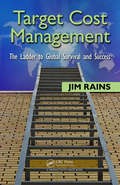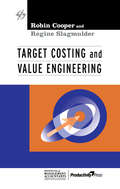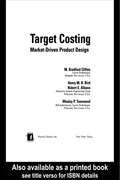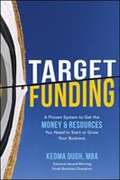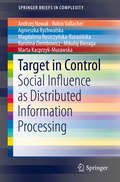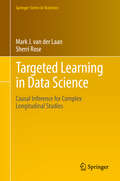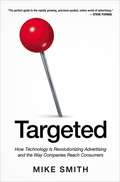- Table View
- List View
Tapping into Altruism: Keeping Talented Women on the Road to Success
by Sylvia Ann HewlettAccording to the author, there are six essential elements that need to gain real traction if a company is to fully realize female talent over the long haul. This chapter looks at some common career drivers for women, addressing one of these essential elements: recognizing and rewarding altruism.
Tapping the Full Potential of ABC
by Thomas G. Cucuzza Joseph A. NessMany companies have used activity-based costing in onetime profitability studies. But when companies integrate ABC into critical management systems and use it to make day-to-day decisions--when they use it as activity-based management--it becomes a powerful tool for continuously rethinking and improving a business. Most managers do not realize that implementing activity-based management is a major organizational-change effort that involves a tremendous amount of work. The biggest obstacle is resistance from employees. The authors focus on two companies--Chrysler Corp. and Safety-Kleen Corp.--whose success in implementing activity-based management can serve as a model for other companies. The benefits they have reaped have been 10 to 20 times their investments in their programs.
Tapping the Groundswell with Twitter: Understanding the Power of Twitter as Part of Your Company's Social Media Strategy
by Charlene Li Josh BernoffPeople who don't use Twitter tend to write it off. What can you say in 140 characters? In fact, the richness that Twitter packs into its tiny updates is amazing. It's caught on because it's free, it's open, and it connects people and gives them power. Twitter has rapidly become a key part of the groundswell-driving, reporting on, and extending activity in everything from blogs to social networks-and given Twitter users an outsized level of influence. In this chapter, social media strategy leaders Charlene Li and Josh Bernoff show how you can turn Twitter into a potent force for connecting with your customers for any of the five groundswell strategy objectives-listening, talking, energizing, supporting, and embracing. Case studies from McDonald's and Intuit demonstrate how different companies have used Twitter to accomplish all of their social media goals. The chapter concludes with a list of must-read, practical suggestions for setting up a Twitter account for your business. This chapter was originally published as Chapter 10 of "Groundswell, Expanded and Revised Edition: Winning in a World Transformed by Social Technologies."
Tar Sands
by Andrew NikiforukTar Sands critically examines the frenzied development in the Canadian tar sands and the far-reaching implications for all of North America. Bitumen, the sticky stuff that ancients used to glue the Tower of Babel together, is the world's most expensive hydrocarbon. This difficult-to-find resource has made Canada the number-one supplier of oil to the United States, and every major oil company now owns a lease in the Alberta tar sands. The region has become a global Deadwood, complete with rapturous engineers, cut-throat cocaine dealers, Muslim extremists, and a huge population of homeless individuals.In this award-winning book, a Canadian bestseller, journalist Andrew Nikiforuk exposes the disastrous environmental, social, and political costs of the tar sands, arguing forcefully for change. This updated edition includes new chapters on the most energy-inefficient tar sands projects (the steam plants), as well as new material on the controversial carbon cemeteries and nuclear proposals to accelerate bitumen production.
Taran Swan at Nickelodeon Latin America (A)
by Linda A. Hill Kristin C. DoughtyEighteen months after launching Nickelodeon Latin America, general manager Taran Swan must leave the company's Miami headquarters for her New York home because of complications with her pregnancy. Unable to travel for at least the next six months, Swan must decide how she will continue to run the channel from New York. Should she put an interim acting head in place, and if so, who among her team should it be? What adjustments will she need to make in her leadership style and working relationships with her team? The case describes the channel's launch and first 18 months on the air, focusing on how Swan puts together her team and crafts the company's culture.
Taran Swan at Nickelodeon Latin America (B)
by Linda A. Hill Kristin C. DoughtySupplements the (A) case.
Taran Swan at Nickelodeon Latin America (C)
by Linda A. Hill Kristin C. DoughtySupplements the (A) case.
Taran Swan at Nickelodeon Latin America (D)
by Linda A. Hill Kristin C. DoughtySupplements the (A) case.
Target Corporation: Ackman versus the Board
by James Weber Krishna G. Palepu Suraj SrinivasanAfter 15 years of great performance, Target's faltering performance during an economic downturn led an activist shareholder to initiate a proxy fight. Target Corporation, the second-largest discount store retailer in the U.S., had competed successfully against industry leader Walmart for years by promoting an upscale discount shopping experience in comparison to Walmart's focus on low prices. This strategy worked well for Target in good economic times. The economic crisis of 2008-2009, however, caused shoppers to abandon Target in favor of Walmart. In the spring of 2009, one of Target's largest shareholders initiated a proxy fight to place his five director nominees on the board. Target won the proxy fight, but still faced questions about whether it had a strategy that could work in both good times and bad.
Target Cost Contracting Strategy in Construction: Principles, Practices and Case Studies (Spon Research)
by Daniel W.M. Chan Joseph H.L. ChanThe problems inherent in the traditional design-bid-build procurement method often lead to the adversarial working relationships within the construction industry. Target cost contracts, accompanied by a gain-share/pain-share arrangement serving as a cost incentive mechanism, have emerged in the United States, the United Kingdom, Australia and Hong Kong with the aim of achieving better value for money and more satisfactory overall project performance under a collaborative working relationship. This book presents the underlying principles, practicalities and a series of short case studies of applying the target cost contracting strategy. Principles begin with the fundamentals then cover the development of target cost contracting in major countries/cities, definitions of target cost contracting, perceived benefits, potential difficulties and critical success factors for implementation. Practices include the target cost contracting approach and process in general, the key risk factors, risk assessment model, risk allocation and risk mitigation measures for target cost contracts in particular, together with a conceptual framework for the performance measurement of target cost contracts. Several short real-life case studies from the United Kingdom, Hong Kong, Australia and New Zealand are provided for further illustration. The book will appeal to a wide spectrum of readers from industrial practitioners to undergraduate students, researchers and academics interested in construction contracts and procurement methods.
Target Cost Management: The Ladder to Global Survival and Success
by Jim RainsWith a proven track record for helping companies achieve critical cost reductions without sacrificing customer satisfaction, target costing provides managers and executives with the tools to survive and prosper in today‘s increasingly competitive market without raising prices on customers. Target Cost Management: The Ladder to Global Survival and S
Target Costing and Value Engineering (Strategies In Confrontational Cost Management Ser.)
by Robin CooperWhat would happen if everyone in your company followed a disciplined approach to cost reduction? Go ahead -- imagine it. What would it look like? How can it be done?The answer -- smart cost management.Effective cost management must start at the design stage. As much as 90-95% of a product's costs are added in the design process. That is why effective cost management programs focus on design and manufacturing. The primary cost management method to control cost during design is a combination of target costing and value engineering.Target Costing Objectives:Identify the cost at which your product must be manufactured at if it is to earn its profit margin at its expected target selling price.Break the target cost down to its component level and have your suppliers find ways to deliver the components they sell you at the set target prices while still making adequate returns.Value Engineering:The connection to function: An organized effort and team based approach to analyze the functions of goods and services that the design stage, and find ways to achieve those functions in a manner that allows the firm to meet its target costs.The result: Added value for your company (development costs on-line with added value for your company; development costs on-line with selling prices) and added value for your customer (higher quality products that meet, possibly even exceed, customer expectations.)
Target Costing: Market Driven Product Design (Mechanical Engineering)
by M. Bradford Clifton Wesley P. Townsend Henry M.B. Bird Robert E. AlbanoCompiling practical recommendations gleaned from more than 20 years of professional experience, Target Costing: Market Driven Product Design provides numerous examples from field authorities that illustrate valuable concepts and approaches employed in the application of target costing to large-scale manufacturing operations. The authors discuss set
Target Funding: Discover A Proven System To Get The Money And Resources You Need Now In Order To Grow Your Business
by Kedma OughTarget Funding ensures that the struggle to obtain funds will never again come between you and your dreams. Too often, great business ideas fail to see the light of day because the entrepreneur doesn’t know how to secure the funding he or she needs. Until now. Target Funding proves you don’t need to be one of these would-be business owners or inventors. No matter what your idea might be, there is funding available to build a solid business or invention around it. Target Funding helps you obtain this and more—even if you have faced bankruptcy, exhausted all avenues, or feel like you are at your wit’s end. Kedma Ough is one of today’s most respected authorities on business funding and entrepreneurship and this practical guide reveals how to locate and secure the necessary funds and resources you need to launch, stabilize, or grow your business dream. She will open your eyes to the vast array of opportunities you didn’t know existed—and provides special insight into beneficial sources before you’re even left the gate. Target Funding takes you on a deep dive into: •The wide range of funding options available for any startup, including un-bankable ventures and independent inventors•Hundreds of vetted funding sources detailing features and eligibility requirements •A winning process for matching funding opportunities with your specific needs•Step-by-step guidance on how to approach funding sources, win them over, and convince them to provide the money you need•Real-life business funding stories that will motivate you to act You'll learn about all the options available to you, including conventional, alternative, and diversity funding. You’ll find out how to access all of them based on your needs, demographic, industry, location, and other variables. Get started on your dream venture today! With Target Funding, you have a proven business-funding strategy to lift your company or invention off the ground and become a sustainable profit machine.
Target Markets: North Korea’s Military Customers (Whitehall Papers)
by Andrea BergerA UN arms embargo has been in place against North Korea for nearly a decade, as part of a broader sanctions regime designed to deny it the goods and funds needed to fuel its nuclear weapons and ballistic-missile programmes. Yet despite these sanctions, a host of state and non-state actors continue to buy arms, material and services from Pyongyang – and inject funds into the same coffers that drive North Korea’s nuclear and missile development. While some of North Korea’s military customers in the sanctions era since 2006 are well known – such as Iran, Syria and Burma – Pyongyang’s wider client base receives little international attention. North Korea has continued to enjoy access to other defence markets across Africa and the Middle East. The drivers of these clients’ decisions to buy weapons and related goods from North Korea are rarely discussed. This gap in analysis is essential to fill. If tailored and effective approaches are to be developed to convince North Korea’s customers to buy elsewhere, they must be based on a sound understanding of the considerations that motivated the client to turn to Pyongyang in the first place. Target Markets comprehensively analyses the available information on these procurement decisions. It concludes, contrary to conventional wisdom, that the reasons that customers buy weapons and related goods and services from North Korea vary, often greatly. This study also concludes that one of the greatest achievements of the UN sanctions regime to date has been to deny North Korea access to modern conventional weapons technology that it can learn to manufacture at home and sell on to its clients around the world. Without more contemporary wares to tempt foreign buyers, North Korea will likely continue to see its client list for weapons and related goods and services shrinking.
Target Your Place: Generation Y--Determining Where You Should Work
by Tamara EricksonYou know what you want to do, but where should you do it? It's important to think broadly and consider a wide range of possible places in which to begin or further your career. Don't fall prey to stereotypes since many work arenas are changing. Some of these shifts include corporations becoming less rigid, entrepreneurial start-ups facing better odds, and government services offering unprecedented opportunity. There are pros and cons to working in each kind of place - it's up to you to weigh those against your needs.
Target in Control: Social Influence as Distributed Information Processing (SpringerBriefs in Complexity)
by Robin R. Vallacher Agnieszka Rychwalska Magdalena Roszczyńska-Kurasińska Karolina Ziembowicz Marta Kacprzyk-Murawska Andrzej K. Nowak Mikolaj BiesagaThis concise monograph introduces and examines social influence from the perspective of the so-called target, rather than from the source, thus providing for the first time a bidirectional account of this pervasive social phenomenon, further bridging simple micro-level dyadic interaction rules with macro-level properties of the (social) system. This integrative approach allows for advanced models of influence to be developed in both the social and natural sciences (e.g. social animals). In particular, when used to investigate emergent properties of social change, this approach shows that social transitions occur as “bubbles of new” in the “sea of old.” While in the traditional view influence is synonymous with achieving power and control over others, the present approach to social influence puts the emphasis on the target’s motives and strategies. Here, the target may actively seek out influence to help forge opinions and achieve guidance regarding courses of action. In this process, the target observes others, models their thought and behavior, and asks for information and opinions. In this broadened perspective, the processes of social influence enables those being influenced (the targets) to use the knowledge and processing capacity of influence sources to maximize their access to information, minimize their processing effort, while optimizing their own functioning and that of the social system in which they evolve. This short text addresses above all scientists interested in social influence in the fields of psychology, sociology, economy, marketing, and biology. However, also researchers interested in modeling social processes, especially opinion dynamics and social change, such as computer scientists, physicists and applied mathematicians will benefit from the insights provided.
Target: Responding to the Recession
by Catherine Ross Ranjay Gulati Rajiv LalWithin 10 months of Gregg Steinhafel's taking over as CEO at Target, the U.S. was mired in the most significant economic downturn in 50 years. Top competitor Wal-Mart had positioned itself well for the crisis, while Target's same store sales began to slide. While Steinhafel believed that Target's long-term strategy and positioning were right, he pondered a set of strategic and operational challenges. Did Target have the right mix of offensive and defensive tactics to weather the downturn and position itself for the economy's eventual recovery? How far could Target go in emphasizing low price-the "pay less" side of its slogan-without eroding the company's core promise of offering unique and upscale products that customers would not see at other low-priced retailers? Would the benefits of adding fresh food to Target's general merchandise stores outweigh the associated challenges?
Targeted Advertising Technologies in the ICT Space
by Christian SchleeIn recent years, the field of information and communication technology has started to change dramatically. Carriers are threatened by high revenue losses requiring them to identify new revenue potentials beyond their core business. Targeted advertising can be one of these revenue opportunities. Christian Schlee provides a broad overview of the latest developments and trends in targeted advertising in the ICT space. The author focuses on the technological aspects of targeted advertising, but also covers business and legal aspects. He analyzes the most interesting use cases in the Web, IPTV, the mobile environment, and in converged scenarios and examines important technological key building blocks.
Targeted Learning in Data Science: Causal Inference For Complex Longitudinal Studies (Springer Series in Statistics)
by Mark J. van der Laan Sherri RoseThis textbook for graduate students in statistics, data science, and public health deals with the practical challenges that come with big, complex, and dynamic data. It presents a scientific roadmap to translate real-world data science applications into formal statistical estimation problems by using the general template of targeted maximum likelihood estimators. These targeted machine learning algorithms estimate quantities of interest while still providing valid inference. Targeted learning methods within data science area critical component for solving scientific problems in the modern age. The techniques can answer complex questions including optimal rules for assigning treatment based on longitudinal data with time-dependent confounding, as well as other estimands in dependent data structures, such as networks. Included in Targeted Learning in Data Science are demonstrations with soft ware packages and real data sets that present a case that targeted learning is crucial for the next generation of statisticians and data scientists. Th is book is a sequel to the first textbook on machine learning for causal inference, Targeted Learning, published in 2011.Mark van der Laan, PhD, is Jiann-Ping Hsu/Karl E. Peace Professor of Biostatistics and Statistics at UC Berkeley. His research interests include statistical methods in genomics, survival analysis, censored data, machine learning, semiparametric models, causal inference, and targeted learning. Dr. van der Laan received the 2004 Mortimer Spiegelman Award, the 2005 Van Dantzig Award, the 2005 COPSS Snedecor Award, the 2005 COPSS Presidential Award, and has graduated over 40 PhD students in biostatistics and statistics.Sherri Rose, PhD, is Associate Professor of Health Care Policy (Biostatistics) at Harvard Medical School. Her work is centered on developing and integrating innovative statistical approaches to advance human health. Dr. Rose’s methodological research focuses on nonparametric machine learning for causal inference and prediction. She co-leads the Health Policy Data Science Lab and currently serves as an associate editor for the Journal of the American Statistical Association and Biostatistics.
Targeted: How Technology Is Revolutionizing Advertising and the Way Companies Reach Consumers
by Mike SmithFar from the catchy television spots and sleek magazine spreads are the comparatively modest ads that pop up on websites and in Internet searches. But don't be fooled--online advertising is exploding. Growing at a compound annual rate near 20%, it is now the second-largest advertising channel in the United States. Part history, part guidebook, part prediction for the future, Targeted tells the story of the companies, individuals, and innovations driving this revolution. It takes readers behind the scenes--examining the growth of digital advertising, its enormous potential, and the technologies that are changing the game forever. Leading the way is real-time bidding, which offers advertisers unprecedented precision in targeting ads and measuring their effectiveness. From keyword micro-markets and ad serving systems to aggregated virtual audiences and new business models, Targeted is sweeping in scope and stripped of technical complexity. It is an essential resource for anyone interested in finding and connecting with customers in the vast and shifting Internet universe.
Targeting Development: Critical Perspectives on the Millennium Development Goals (Routledge Studies In Development Economics Ser. #36)
by Howard White Richard BlackThe Millennium Development Goals accepted by the UN in 2000 are, along with the targets set by the OECD in 1996 the subject of this expertly written book. Is development achievable in the time frames given? How useful were the goals in the first place? How far have we come in solving the aching problems of the developing world? These questions and
Targeting Myth Markets: The First Step in Developing a Cultural Branding Strategy
by Douglas B. HoltIdentity brands are different from those competing in product markets. They participate in myth markets, competing and collaborating with other cultural products like films, music, television, sports, and books. The first step of your cultural branding strategy, therefore, must be identifying and targeting the most appropriate myth market.
Targeting Regional Economic Development (Routledge Studies in Global Competition)
by Steven C. Deller Stephan J. Goetz Thomas R. HarrisTargeting regional economic development (TRED) has a long and rich tradition among academic economists and in the world of economic development practitioners. This book builds on a series of workshops and papers organized by The Northeast Regional Center for Rural Development (NERCRD) at the Pennsylvania State University and the Rural Policy Research Centre (RUPRI) at the University of Missouri. Through the coordinated efforts of NERCRD and RUPRI, a network of university based researchers and Extension education specialists was developed and provides the foundation of this new edited volume. For the first time in a single book, Goetz, Deller and Harris present an innovative approach through a collection of chapters discussing industry targeting and the relevance of TRED as an important analytical tool for practical targeting purposes. The papers present issues surrounding community economic development, clusters in industry and rural communities and the role of agglomeration economies. The book provides the reader with insights into not only the theoretical foundations of targeting as well as empirical methods, but also approaches for using the community-level analysis to affect policy directions.



